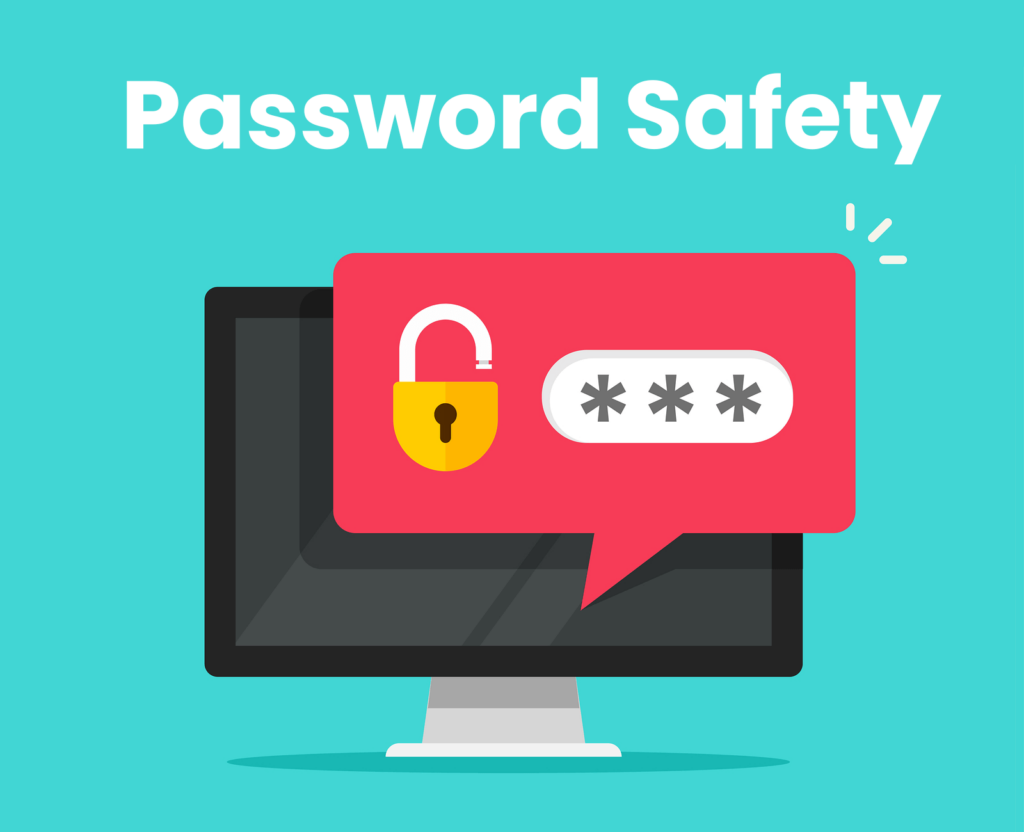Fortify Your Digital Fortress: Comprehensive Password Tips to Ensure Unwavering Online Safety

Introduction:
In an era where our lives are intricately interwoven with the digital realm, the security of our online presence has never been more critical. Passwords act as the frontline defense against cyber threats, making it imperative to fortify them with robust strategies for enhanced online safety. This comprehensive guide unveils a myriad of password tips, ranging from the basics of creating secure passwords to advanced techniques for safeguarding your digital identity against evolving cyber threats.
I. The Importance of Strong Passwords:
A. Cybersecurity Landscape:
- Rising Threats: With the proliferation of cyber threats, strong passwords serve as the first line of defense against unauthorized access.
- Personal and Financial Security: Secure passwords protect not only personal information but also financial assets and sensitive data.
B. Password Hygiene:
- Multiple Online Accounts: With the average person managing numerous online accounts, maintaining strong passwords is crucial to prevent unauthorized access across platforms.
- Identity Protection: Strong passwords are instrumental in safeguarding your digital identity, preventing identity theft and unauthorized account takeovers.
II. Creating Strong Passwords:
A. Password Length:
- Longer is Stronger: Aim for longer passwords, as they provide a more substantial defense against brute force attacks.
- Passphrase Approach: Consider using a passphrase, combining multiple words or a memorable phrase to create a strong and easily recallable password.
B. Complexity Matters:
- Mix Character Types: Incorporate a mix of uppercase and lowercase letters, numbers, and special characters for increased complexity.
- Avoid Predictable Patterns: Steer clear of easily guessable patterns, such as “123456” or “password.”
C. Unique Passwords:
- Avoid Reuse: Refrain from using the same password across multiple accounts to mitigate the risk of a single breach compromising multiple services.
- Password Manager: Utilize a reputable password manager to generate and store unique, complex passwords for each account.
III. Password Manager Best Practices:
A. Generate Complex Passwords:
- Automated Generation: Password managers can automatically generate complex, random passwords that are virtually impossible to guess.
- Length and Variety: Leverage the password manager’s capability to create long and diverse passwords for heightened security.
B. Secure Storage:
- Encryption: Password managers use robust encryption algorithms to secure your password vault, ensuring that your passwords remain confidential.
- Master Password Strength: Choose a strong master password for your password manager, as it serves as the gateway to your entire password vault.
C. Regular Updates:
- Password Audits: Periodically conduct password audits to identify and update weak or compromised passwords stored in your manager.
- Software Updates: Keep your password manager updated to benefit from the latest security features and improvements.
IV. Two-Factor Authentication (2FA):
A. Enhanced Security Layer:
- Dual Verification: 2FA adds an extra layer of security by requiring a second form of verification, typically a code sent to your mobile device.
- Biometric Authentication: Some services offer biometric authentication as a second factor, using fingerprints or facial recognition.
B. Enable 2FA Across Accounts:
- Widespread Adoption: Many online services and platforms support 2FA. Enable it wherever possible to bolster your account security.
- Authentication Apps: Consider using authentication apps, such as Google Authenticator or Authy, for generating 2FA codes.
V. Password Update Frequency:
A. Regular Password Changes:
- Periodic Updates: Change your passwords regularly, especially for critical accounts like email and banking.
- Timely Response: Promptly change passwords in the event of a security breach or if you suspect unauthorized access.
B. Avoid Predictable Patterns:
- Variation in Updates: Vary your password update patterns to avoid predictability. Don’t rely on changing a single character or incrementing numbers.
- Uniqueness: Ensure that each updated password is unique and does not follow a predictable sequence.
VI. Educating Against Social Engineering:
A. Phishing Awareness:
- Recognizing Phishing Attempts: Educate yourself on common phishing techniques, such as fraudulent emails or fake websites attempting to steal your credentials.
- Verify Sources: Always verify the legitimacy of emails or messages before clicking on links or providing login information.
B. Social Engineering Tactics:
- Manipulative Techniques: Be aware of social engineering tactics that manipulate individuals into divulging confidential information.
- Verify Requests: If you receive unexpected requests for passwords or sensitive information, verify the legitimacy of the request through official channels.
VII. Secure Recovery Options:
A. Account Recovery Measures:
- Alternate Email: Provide a secure alternate email address for account recovery purposes.
- Mobile Number: Link a secure mobile number to your accounts for two-factor authentication and recovery.
B. Security Questions:
- Avoid Common Answers: Choose security questions with answers that are not easily discoverable or publicly available.
- Unique Responses: Provide unique responses that are not easily guessable by individuals with knowledge of your personal life.
VIII. Security Practices for Specific Accounts:
A. Email Security:
- Priority Account: Since email often serves as a gateway to other accounts, prioritize securing your email with a strong, unique password.
- Two-Factor Authentication: Enable 2FA for your email account to add an extra layer of protection.
B. Banking and Financial Accounts:
- Strong Authentication: Use robust authentication methods for financial accounts, including strong passwords and 2FA.
- Regular Monitoring: Regularly monitor financial transactions and report any suspicious activities immediately.
C. Social Media Accounts:
- Privacy Settings: Adjust privacy settings on social media platforms to control the visibility of personal information.
- Account Recovery: Secure social media accounts with strong passwords and enable account recovery options.
IX. Secure Browsing Practices:
A. HTTPS Adoption:
- Check for HTTPS: Ensure websites use HTTPS for secure data transmission, especially when entering passwords.
- Browser Extensions: Consider using browser extensions that force HTTPS connections for added security.
B. Avoid Public Wi-Fi Risks:
- Use VPNs: When accessing sensitive accounts on public Wi-Fi, use a Virtual Private Network (VPN) to encrypt your connection.
- Log Out: Log out of accounts after use on public computers or shared devices to prevent unauthorized access.
X. Staying Informed about Security Threats:
A. Security Updates:
- Stay Informed: Keep yourself updated on the latest cybersecurity threats and trends through reputable sources.
- Patch Management: Regularly update your devices, operating systems, and software to patch security vulnerabilities.
B. Security Awareness Training:
- Continuous Learning: Engage in ongoing security awareness training to stay vigilant against evolving threats.
- Phishing Simulations: Participate in phishing simulation exercises to sharpen your ability to recognize and avoid phishing attempts.
XI. Safe Password Sharing:
A. Limited Sharing:
- Avoid Sharing: Refrain from sharing passwords whenever possible, especially for sensitive accounts.
- Secure Sharing Methods: If password sharing is necessary, use secure methods such as password managers that facilitate encrypted sharing.
B. Temporary Access:
- Change Passwords After Sharing: If temporary access is granted, change the password after the designated period to maintain security.
- Multi-User Accounts: Utilize multi-user account features for platforms that support shared access.
XII. Legacy and End-of-Life Account Management:
A. Account Closure:
- Close Unused Accounts: Regularly review and close accounts that are no longer in use to minimize potential security risks.
- Data Deletion: Ensure that all personal data is deleted when closing accounts, and follow the platform’s account closure procedures.
B. Account Inheritance:
- Legacy Planning: Establish a plan for the management of digital assets and accounts in the event of incapacity or passing.
- Legal and Trusted Contacts: Share necessary information with legal representatives or trusted contacts for account management in unforeseen circumstances.
XIII. Continuous Evaluation and Adaptation:
A. Periodic Security Audits:
- Review Security Settings: Periodically review and update security settings for all accounts.
- Password Audits: Conduct password audits using password managers to identify and update weak or compromised passwords.
B. Stay Informed about Security Trends:
- Industry News: Stay abreast of cybersecurity news and emerging threats to adapt your security practices accordingly.
- Technology Advancements: Embrace advancements in security technologies and implement them for enhanced protection.
XIV. Future Trends in Password Security:
A. Biometric Authentication:
- Widening Adoption: Biometric authentication, such as fingerprint and facial recognition, may become more prevalent as a primary or secondary authentication method.
- Continuous Authentication: Advanced systems may implement continuous authentication, constantly validating a user’s identity during a session.
B. Passwordless Authentication:
- Eliminating Passwords: Passwordless authentication methods, like hardware tokens or mobile authentication, may become more widespread.
- Zero Trust Security: The adoption of a zero-trust security model may reduce reliance on traditional passwords.
C. Artificial Intelligence in Authentication:
- Behavioral Biometrics: AI-driven behavioral biometrics may be employed to analyze and authenticate user behavior patterns.
- Anomaly Detection: AI algorithms may play a crucial role in detecting and mitigating anomalies in user behavior that could indicate unauthorized access.
Conclusion:
In the ever-evolving landscape of cybersecurity, the strength of your passwords remains a cornerstone of your digital defense. This comprehensive guide has equipped you with a wealth of password tips, ranging from fundamental practices to advanced strategies, to ensure unwavering online safety. By implementing these measures and staying vigilant against emerging threats, you fortify your digital fortress and navigate the digital world with confidence, safeguarding your personal and financial well-being in an increasingly interconnected and dynamic environment.







